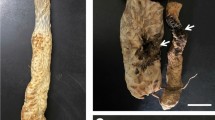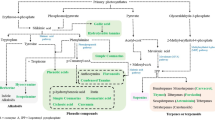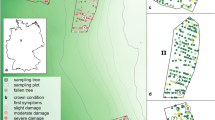Abstract
In the years 2004–2006 the species P. sclareae was isolated from sage stems showing the symptoms in the form of bark peeling off and breaking. On the basis of 5 isolates randomly chosen from the fungus population, morphology and the conditions of temperatures favourable for the most intensive growth and creation of the fungus infectious material were studied. The temperature of −6°C was viewed as unfavourable for the fungus growth, and that of 32°C was considered to prevent the formation of picnidia and conidia. The dynamic growth of the colonies and the formation of numerous picnidia and conidia were observed at the temperatures ranging from 20°C to 28°C.
Similar content being viewed by others
References
Beus C. 2005. Growing and marketing Lavender. Farming the Northwest series small Farms Team, pp. 1–28.
Coélho R.M.S., Castro H.A. & De Menezes M. 1997. Esporulaco de Phomopsis e Phoma em diferentes meios de cultura e condicôes de temperatore e luminosidade. Summa Phytopathologica 23: 176–180.
Gabler J. & Ehrig F. 2000. Phomopsis diachenii Sacc., ein aggressiver Krankheitserreger an Kümmel (Carum carvi) — Erstnachweis für Deutschland. Z. Arzn. Gew. Pfl. 1: 36–39.
Gruyter J. De. & Noordeloos M.E. 1992. Contributions towards a monograph of Phoma (Coelomycetes) — I.1. Section Phoma: Taxa with very small conidia in vitro. Persoonia 15: 71–92.
Horn W.S., Simmonds M.S.J., Schwartz R.E. & Blaney W.M. 1996. Variation in production of phomodiol and phomopsolide B by Phomopsis spp. Mycologia 88: 588–595.
Król E. 2005. Influence of some chemicals on the viability of Phomopsis viticola Sacc. spores. J. Plant Protec. Res. 45: 195–204.
Laine A.L. 2003. First report of Phomopsis subordinaria in natural population of Plantago lanceolata in south-west Finland. Plant Pathology 52: 422–423.
Ľacicowa B. 1970. Badania szczepów Helminthosporium sorokinianum ( = H. sativum) oraz odporność odmian jęczmienia jarego na ten czynnik chorobotwórczy. Acta Mycol. 6: 187–248.
Machowicz-Stefaniak Z. & Kuropatwa E. 1993. Pathogenicity of Phomopsis viticola Sacc. for grapevines (Vitis vinifera L.) under foil tunnel conditions. Phytopathol. Pol. 5: 67–72.
Machowicz-Stefaniak Z., Zimowska B. & Zalewska E. 2008. The occurrence and pathogenicity of Phoma exigua Desm. var. exigua for selected species of herbs. Acta Agrobot. 61: 157–166.
Nelson P.E., Toussoun T.A. & Marasas W.F.O. 1983. Fusarium species. An Illustrated Manual for Identification. The Pennsylv. ST. Univ. Press. University Park and London, 193 pp.
Ramirez C. 1982. Manual and Atlas of the Penicillia. Elsivier Biomedical Press, Oxford, 874 pp.
Subbiah V.P., Riddick M. & Peele D. 1996. First report of Fusarium oxysporum on clary sage in north America. Plant Dis. 80: 1080.
Sutton B.C. 1980. The Coelomycetes, Fungi imperfecti with pycnidia, acervuli and stromata. Comm. Mycol. Inst., Kew, Surrey, England, 696 pp.
Uecker F.A. 1988. A word list of Phomopsis names with notes on nomenclature, morphology and biology. Mycol. Mem. 13, 321 pp.
Voltolina G. 2001. Salvia sclarea L. Plante Officinali 2: 1–12.
Zalewska E. 2008. Occurrence and characterization of Septoria carvi Syd. (Coelomycetes, Sphareopsidales). Herba Pol. 54: 25–33.
Zimowska B. 2002. Wpływ warunków hodowli na wzrost, zarodnikowanie i tworzenie struktur morfologicznych przez Seimatosporium hypericinum (Ces.) Sutton. Acta Agrobot. 55: 401–410.
Zimowska B. 2004. Occurrence, biology and some morphology elements of Seimatosporium hypericinum, a pathogen of St. John’s wort (Hypericum perforatum L.). Phytopathol. Pol. 34: 41–50.
Zimowska B. 2007. New Phoma species on Leonurus cardiaca. Acta Mycol. 42: 119–123.
Zimowska B. 2008a. Fungi threatening the cultivation of sage (Salvia officinalis L.) in south-eastern Poland. Herba Pol. 54: 15–24.
Zimowska 2008b. Biodiversity of fungi colonizing and damaging selected parts of motherwort (Leonurus cardiaca L.). Herba Pol. 5: 30–40.
Zimowska B. & Machowicz-Stefaniak Z. 2005. Charakterystyka izolatów Phoma strasseri nie notowanego w Polsce patogenu mięty pieprzowej (Mentha piperita L.). Acta Agrobot. 58: 151–161.
Author information
Authors and Affiliations
Corresponding author
Rights and permissions
About this article
Cite this article
Zimowska, B. Characteristics of Phomopsis sclareae obtained from sage (Salvia officinalis). Biologia 65, 603–608 (2010). https://doi.org/10.2478/s11756-010-0060-4
Received:
Accepted:
Published:
Issue Date:
DOI: https://doi.org/10.2478/s11756-010-0060-4




